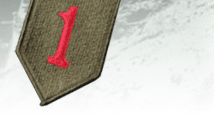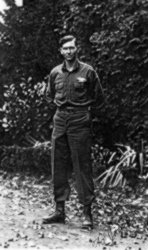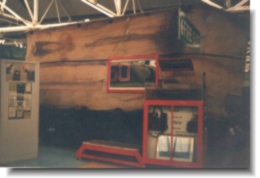Victor Miller 5th Ranger Bat., Omaha Beach, Dog Green, 0730
Victor Miller was a staff-sergeant in the heavy weapons section(E company) of the fifth Ranger battalion. Here are his experiences of the landing on D-day. When embarkation-time came our battalion was divided over two British Mercheants. The assault boats, the LCA's, were suspended around the sides of these ships. We had been told that we were going to climb down rat lines into the LCA's after they had been lowered in the water, but for some reason they spared us that hazardous climb down the nets and the LCA's were not lowered before all were aboard. The sea was pretty rough. We were each issued two puke bags, and in our boat of 30-some men, there were only two of us that didn't use them. Probably most of them used both. We were really crammed into these assault boats, there was absolutely no room back or front. The boat pitched quite a bit which made ideal circumstances for seasickness. We were not aware of the fact that Colonel Rudder was unsuccessful in signalling to the rest of the rangers that he had climbed the rocks at Pointe du Hoc and that Colonel Schneidder then had decided to set sail for Omaha Beach. As we approached the beach, Colonel Schneidder saw that the section with codename Dog White was a lot more quite than the section in which we were scheduled to land. He figured that it was best to land in that spot and he ordered all seventeen LCA's carrying rangers to land on Dog White. We did not knew all this at that time. When we approached the beach it didn't look like we thought it should. The grass apparently was burning there from the many shells that had landed on it. When we got closer we could see tracers coming down the beach which wasn't a very promising sight. We saw obstacles sticking up, which were triangular pieces of steel with mines dangling from them. We ultimately got to a point where the British coxswain on our boat said, "I'm aground, I'm aground" He dropped the ramp and lieutenant Anderson who was in the front yelled "All out" and then he jumped out. He immediately disappeared beneath the waves, and some in front of the boat were just in time to reach down and dragged him back in the boat. Sergeant Charles VanderVoort then simply put his tommy gun in the ribs of the coxswain and said, "I think you had better get us ashore". I might say that our boat, under those circumstances, probably got closer to the actual sand beach than any other. We were able to get out without getting in water more than to our knees. You couldn't really blame the ship's crew, because as soon as they got us out they were able to leave this dangerous spot, so it was no wonder they were eager to get us out. It must have been 7:30 at that time. As we were starting to unload, I noticed that the 2nd boat of our company wasn't quite so fortunate as we were. They were getting off in waist-deep water and I watched them get off while I awaited my turn to get off myself. I saw George C Lawton jump into the water. He wasn't very tall and because he was an ammunition carrier he was laden with mortar shells. He was into the water to his armpits and he couldn't make any progress at all. Sergeant Beccue who was a pretty rugged character had spotted George as well and although he himself was already on the beach he went back into the water, grabbed George and dragged him to the shore. When it was my turn to leave the boat, I dashed for the rocks at the top off the beach in one long run. There we were instructed to stay still and wait until the officers had gotten together to decide just what our next move should be. The tide was now coming in a bit and this started to be a serious problem for a number of wounded that were scattered along the beach at the places they had been hit. They were crying out to us, but if they couldn't move themselves there was little we could do for them, at least from our point of view. Most of them eventually drowned.
I was lying on the rocks alongside of our company clerk John Spurlock, and I remember that John was carefully reaching under him and lifting a rock at a time, and moving it to make his body get lower and lower, which wasn't a bad idea at all. The officers finally decided that we had to forget about our original mission for the moment and had to concentrate on creating a beachhead, since the infantry (the 116th Regiment) that had proceeded us on the beach had not made any progress so far. The engineers brought in the bangalore torpedo's and shoved them under the barbed wire that was running along the seawall at the top of the beach. When a breech was blown in this seawall, we could start our ascent on this very steep hillside, which was still obscured by smoke. While going up the hill I suddenly realized that one of my squads was missing. Both squads had been by my side the whole time, but now one was gone. I decided to go back down the hill and there I found my men. When I asked for an explanation why they weren't yet on their way to the top, they told me that someone had told them that there was a minefield on the road to the top. I drove them up the hill and once there they too realized that they were safer there than on the beach. We could hear the shells go overhead on their way to the beach. When we were at the top of the hill we came to the road that runs parallel to the beach through Vierville sur Mer. From there we looked back on the beach before we went inland. We saw an LSI (Landing Ship Infantry) with men disembarking down the stairways on both sides. Suddenly these men were engulfed in flames. Apparently one of the men carrying a flame-thrower had been hit by a shell or bullet and his tank had exploded. The front of the ship simply disappeared in flames. With that terrible image in our minds we turned our backs to the beach and moved on inland.
Continue reading about Victor MillerTraining for the landing |

 The first wave that landed on Omaha Beach on d-day consisted of elements of the 16th Infantry Regiment of the First Division, as we have seen in the story of Mike McKinney. Elements of the 116th Infantry Regiment landed at the same time on west end of Omaha across from Vierville-sur-mer. The 116th Infantry Regiment was part of the 29th Infantry Division, but for D-day it had been attached to the 1st Division. A small group of rangers were assigned with a special task. According to Allied intelligence was a German build battery of six 155mm canons located on top of a cliff called point du Hoc. This cliff was positioned between Utah and Omaha beach, five miles west of Omaha beach. When it was able to fire in the first hours of the invasion, it could do severe damage to the supply lines towards both beaches. Heavy casualties among the first waves could be a result of accurate fire from this battery. The companies D, E and F of the second ranger battalion were going to land at the bottom of the cliff at h-hour. They would then attempt to climb the cliffs with mortar-launched rope-ladders and try to silence the battery. The commander of the first wave, Colonel Rudder would give a signal within forty-five minutes after the landing, if the attack on the battery had been successful. If he gave the signal, a second wave of rangers consisting the remainder of the second battalion and the fifth ranger battalion would reinforce the rangers on the cliff. In the event that Rudder was unable to give the signal, the second wave would land in the already established beachhead on Omaha Beach and advance through the lines of the 116th Infantry Regiment and attack the battery of pointe du Hoc from the rear.
The first wave that landed on Omaha Beach on d-day consisted of elements of the 16th Infantry Regiment of the First Division, as we have seen in the story of Mike McKinney. Elements of the 116th Infantry Regiment landed at the same time on west end of Omaha across from Vierville-sur-mer. The 116th Infantry Regiment was part of the 29th Infantry Division, but for D-day it had been attached to the 1st Division. A small group of rangers were assigned with a special task. According to Allied intelligence was a German build battery of six 155mm canons located on top of a cliff called point du Hoc. This cliff was positioned between Utah and Omaha beach, five miles west of Omaha beach. When it was able to fire in the first hours of the invasion, it could do severe damage to the supply lines towards both beaches. Heavy casualties among the first waves could be a result of accurate fire from this battery. The companies D, E and F of the second ranger battalion were going to land at the bottom of the cliff at h-hour. They would then attempt to climb the cliffs with mortar-launched rope-ladders and try to silence the battery. The commander of the first wave, Colonel Rudder would give a signal within forty-five minutes after the landing, if the attack on the battery had been successful. If he gave the signal, a second wave of rangers consisting the remainder of the second battalion and the fifth ranger battalion would reinforce the rangers on the cliff. In the event that Rudder was unable to give the signal, the second wave would land in the already established beachhead on Omaha Beach and advance through the lines of the 116th Infantry Regiment and attack the battery of pointe du Hoc from the rear.

 We saw very few tanks on the beach. We later heard that the tanks that were supposed to swim to the beach simply sank when they drove off the transport ships. We did see one tank, it was running up and down the beach and didn't seem to be accomplishing anything, other than almost running over some of the wounded who couldn't get out of the way.
We saw very few tanks on the beach. We later heard that the tanks that were supposed to swim to the beach simply sank when they drove off the transport ships. We did see one tank, it was running up and down the beach and didn't seem to be accomplishing anything, other than almost running over some of the wounded who couldn't get out of the way.